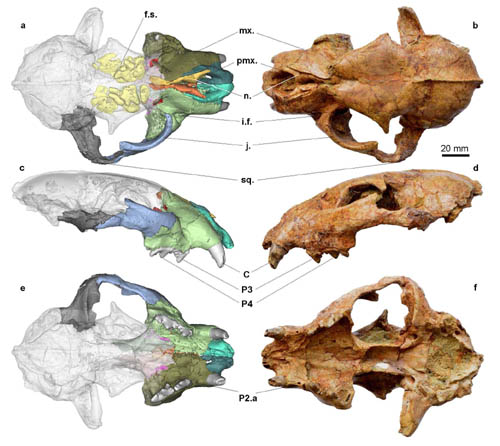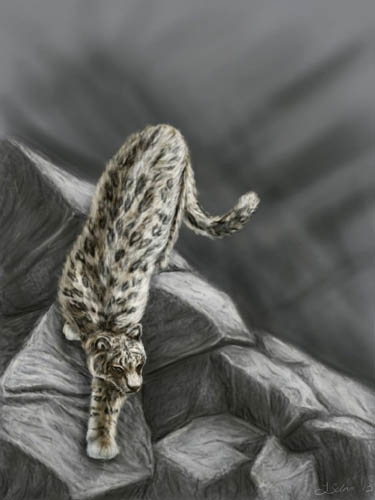New Pantherine Fossils Found From the Zanda Basin of the Tibetan Himalaya
Pantherine felids, known as “big cats”, include the largest living cats, apex predators in their respective ecosystems. Although the oldest pantherine fossils occur in Africa, molecular phylogenies point to Asia as their region of origin. There was a division between the DNA data and the fossil record, mainly because early big cat fossils are exceedingly rare and fragmentary. An international team led by Dr. Xiaoming Wang, Natural History Museum of Los Angeles County, and Dr. LI Qiang, Institute of Vertebrate Paleontology and Paleoanthropology (IVPP), Chinese Academy of Sciences, reported the discovery of a fossil pantherine, Panthera blytheae, from the Tibetan Himalaya, with an age of Late Miocene–Early Pliocene, replacing African records as the oldest pantherine and extending the pantherine record back by 2 million years. This study published November 14 in the Royal Society journal Proceedings B supports the theory that big cats evolved in central Asia - not Africa - and spread outward.
The holotype of Panthera blytheae is a partial cranium preserving the first left incisor, canines, and the third and fourth premolars, representing a full adult individual. It was found at IVPP locality ZD1001 (31839’5800 N, 79844’5700 E, elevation 4114 m) in 2010, which is adjacent to the Zanda Canyon trail approximately 15 km north of the Zanda county seat, Ngari District, Tibet Autonomous Region, China.
Researchers performed a phylogenetic analysis of four fossil and six living pantherine species using the first combined morphological and molecular dataset for this group. Their analysis includes DNA sequences previously used in molecular studies of felid evolution, plus ancient mitochondrial DNA (mtDNA) previously published for extinct ‘cave lions’ Panthera spelaea and “American lions” Panthera atrox.
The ‘total evidence’ phylogenetic analysis of pantherines indicates that the new cat is closely related to the snow leopard and exhibits intermediate characteristics on the evolutionary line to the largest cats. "This cat is a sister of living snow leopards - it has a broad forehead and a short face. But it's a little smaller - the size of clouded leopards," said lead author Dr Jack Tseng of the University of Southern California.
Historical biogeographic models provide robust support for the Asian origin of pantherines. The combined analyses indicate that 75% of the divergence events in the pantherine lineage extended back to the Miocene, up to 7 million years earlier than previously estimated. The deeper evolutionary origin of big cats revealed by the new fossils and analyses indicate a close association between Tibetan Plateau uplift and diversification of the earliest living cats.
The new specimens permit a robust time-calibrated cladistic analysis of the most comprehensive combined morphological and molecular dataset for this lineage to date. “The new pantherine fossils from the Zanda Basin fill in the approximately 4 million year time gap between previously known species records and estimated molecular divergence time for pantherines”, said Dr LI Qiang, “However, the exact timing of divergence events within the big cat lineage awaits additional data to provide narrower confidence intervals, especially for the early cladogenetic timing in the Middle and Late Miocene.”
"The incorporation of historical biogeographic analysis tools with the combined dataset indicates that molecular and fossil evidence are now in agreement regarding the Asian origin of big cats, and further pinpointing a geographical region still occupied today by the earliest branching species in the lineage. Evidence of similar environmental conditions and long-term associations between cold-adapted predator and prey species found in the Zanda Basin suggests that future studies of its fossil fauna will provide important data not only on the evolutionary stability of endemic lineages, but also how their eventual dispersal outside the plateau is linked to tectonic, climatic and biotic events”, said Dr. Xiaoming Wang.
This study was mainly supported by National Basic Research Program of China (973 program) and Chinese Academy of Sciences. 
Fig.1 The holotype of Panthera blytheae (Image by Z. Jack Tseng) 
Fig.2 The artist's reconstruction of Panthera blytheae (Image by Julie Selan)
Download attachments: